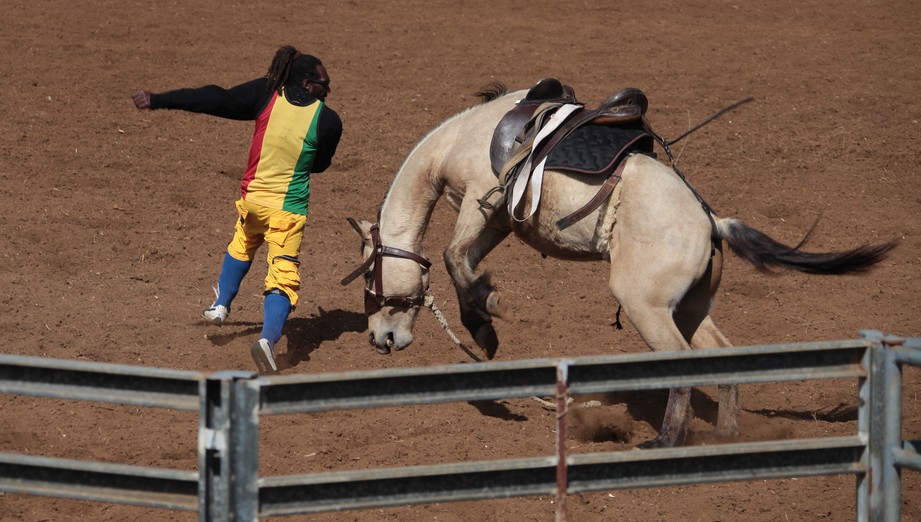CLOWN DE RODEO
A rodeo clown, also known as a bullfighter (US/Canada) or rodeo protection athlete, is a rodeo performer who works in bull riding competitions. The primary job of the rodeo clown is to protect a fallen rider from the bull, whether the rider has been bucked off or has jumped off of the animal. The rodeo clown distracts the bull and provides an alternative target for the bull to attack. These individuals expose themselves to great danger in order to protect the cowboy. To this end, they wear bright, loose-fitting clothes that are designed to tear away, with protective gear fitted underneath. Rodeo clowns require speed, agility, and the ability to anticipate a bull's next move. Working closely with very large, very powerful animals, rodeo clown are often injured seriously, and, sometimes, fatally. In some venues, rodeo clowns wear clown makeup and some may also provide traditional clowning entertainment for the crowd between rodeo events, often parodying aspects of cowboy culture. However, many modern bullfighters do not dress as clowns. At larger events, the American style bullfighter is one of three types of rodeo clown hired, along with a barrelman and comic, or traditional clown. Some barrelmen provide both comedy and support to bullfighters, but the job of a bullfighter is generally distinct from that of the comic.
History
Bullfighting was reported as Wick Peth's profession in 1967, and Jimmy Anderson was reported to have begun his career in 1975. In Australia, rodeo clowns were a part of rodeos and agricultural shows for many years. They were hired to entertain the spectators between events and to help manage the bullocks, steers or bulls in the arena. In the 1930s, with the introduction of aggressive Brahman bulls and Brahman crossbreds, the job became much more serious. In the late 20th century, acknowledging the great danger faced by the profession, the term bullfighter began to replace the name rodeo clown in formal use. The comedy aspect of clown work, as opposed to protection of rodeo athletes, began to disappear in the USA by the late 1970s.
Technique
The rodeo clowns enter the rodeo arena on foot, before the bull is released from the bucking chute. They stand on either side of the chute as the bull is released and work as a team to distract the bull and thus protect the rider and each other. Their role is particularly important when a rider has been injured, in which case the rodeo clown interposes himself between the bull and the rider, or uses techniques such as running off at an angle, throwing a hat, or shouting, so that the injured rider can exit the ring. When a rider has been hung up, they face the extremely dangerous task of trying to free the rider, with one team member going to the bull's head and the other attempting to release the rider. Typically, rodeo clowns work in groups of two or three, with two free-roaming rodeo clowns and sometimes a third, often more clownish-behaving team member, who is known as the barrel man. The barrel man uses a large padded barrel that he can jump in and out of easily, and the barrel helps to protect the rodeo clown from the bull. In Australia, rodeo clowns generally do not use barrels. A rodeo clown's job can be quite dangerous, as in this example of a person being gored by a bull.
Competition
Bullfighting has grown in popularity, so that in addition to being a job in its own right, it is a competitive event at rodeos around the United States. When not working to protect bull riders, rodeo clowns also have their own performances. Bulls are turned into the arena and the clown works with the animal, evaluated based upon the aptitude he displays in controlling and maneuvering the bull, precision in jumping the bull, contact with the bull, and handling of the barrel. Similar skills are sometimes displayed at traditional rodeos in intermission acts. A typical format is a 60- or 70-second encounter between bull and bullfighter, in which the bullfighter scores points for various maneuvers. In contrast to the older sport of bullfighting, no harm is done to the bull in rodeo bullfighting.
Recognition
From 1981–2000, Wrangler Jeans sponsored the Bullfighter of the Year contest at the National Finals Rodeo, The California Cowboys Professional Rodeo Association designates a Bullfighter of the Year annually. Other titles include the American Cowboys Association Freestyle Bullfighting Champion and the Ultimate Challenge Freestyle Bullfighting Champion. Schools exist to provide training for potential rodeo clowns.
